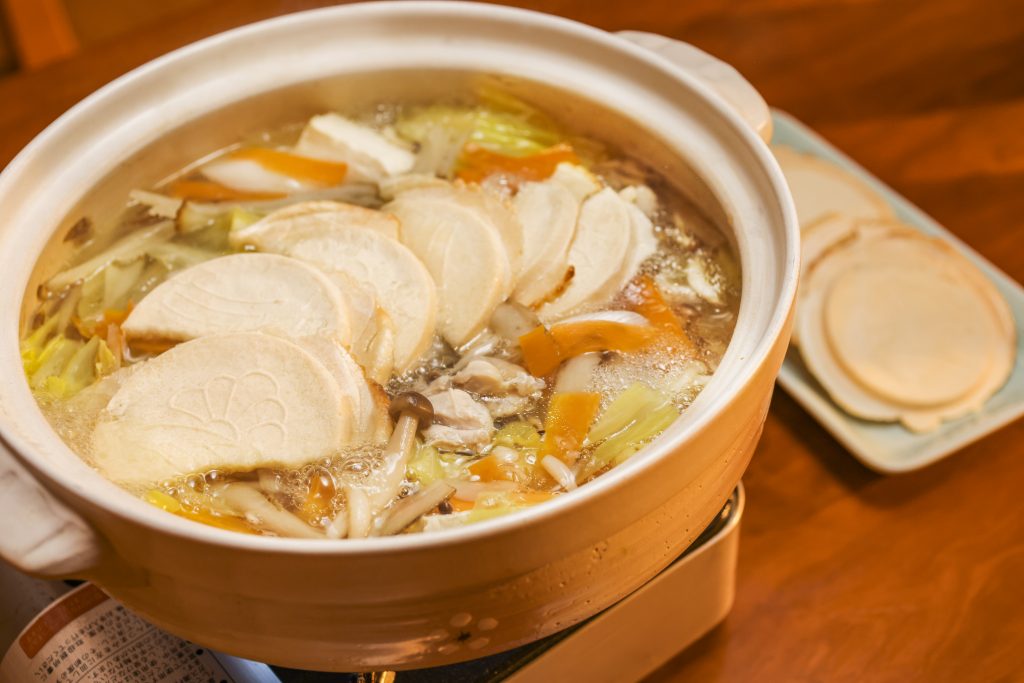One of the incredible and unique things to experience in Japan is it’s food culture. When it comes to Japanese cuisine seafood is the jewel in its crown.
You can experience exquisite seafood all over Japan, but the freshest and best place to try it is at the source. Hachinohe, with its expansive coasts and rich history of fishing, is a treasure trove of seasonal seafood.
The area’s location between the mountains and the ocean also makes it ideal for vegetables, fruit, and meat and the regional cuisine reflects this. The area is well known by Japanese gourmets, who travel from far and wide to experience locally produced delicacies. Like all traditional Japanese food the cuisine changes with the seasons, reflecting the available bounty of nature. During the Winter months there are a huge selection of dishes to warm your body and soul. Take a look at our proposed Hachinohe Gourmet Winter menu.
Hachinohe Wheat Cracker Stew (Senbei Jiru)

Because the North West of Japan was traditionally not as rich in rice production as other areas, they relied on wheat or buckwheat for their carbohydrate fix. Japanese senbei crackers are usually made of rice flour, but in shops and supermarkets around Hachinohe you will be able to find nanbu senbei – Wheat Crackers.The local favourite Hachinohe Wheat Cracker Stew has a base of chicken or mushroom soup loaded with produce from the area, such as burdock root or yam noodles and topped with wheat crackers. The crackers are left to absorb the flavours until they are “just right”. This hearty meal is guaranteed to warm you up on a brisk night.Hachinohe Wheat Cracker Stew has grown in popularity and now there are many varieties available, as well as merchandise and souvenirs featuring the stew.

Hachinohe is a well known seafood hub, and the city’s restaurants and hotels have even set up their own festival to celebrate the myriad offerings of the ocean. The Hachinohe Bouillabaisse Festival is held every winter from February to March and is an opportunity for local businesses to showcase their creativity and skill. Each venue creates their own dish following two important rules:The bouillabaisse must be prepared with at least four different types of seafood from the port of Hachinohe.Each restaurant must prepare a secondary dish that utilises the soup of bouillabaisse in an original way.Participating restaurants range from traditional Japanese to Portuguese and Italian, and they all utilise their unique skills and influences to produce unique variations inspired by the French classic and the delicious fresh seafood of the region.
If you are looking for the freshest seafood and vegetables, you should visit Hasshoku Centre. Approximately 60 stores sell local produce and souvenirs, and you can even grill the items that you purchase on site at one of the dedicated dining areas. Whatever the season, this is a great place to taste local specialities prepared simply to enhance their natural flavours and textures.It is good to know that after you have enjoyed Hachinohe’s natural rugged beauty, enhanced by the dramatic Winter backdrop, you can warm up and enjoy a whole range of delicious cuisine.
How to access Hachinohe
From Tokyo : About 2 hours and 45 minutes by Shinkansen Bullet Train
From Osaka (Itami Airport) : About 1 hour and 35 minutes by flight to Misawa Airport
From Sapporo (Okadama Airport) : About 1 hour by flight to Misawa Airport
For more information please see the VISIT HACHINOHE website here.
| About VISIT HACHINOHE The Hachinohe Area is comprised of eight regions; Hachinohe City, Sannohe Town, Gonohe Town, Takko Town, Nanbu Town, Hashikami Town, Shingo Village and Oirase Town. The VISIT HACHINOHE organization has simple goals: to raise awareness about the unique and amazing attributes of the Hachinohe Area as a domestic and international travel destination, to establish Hachinohe as a brand known for its quality and excellence, to increase the number and satisfaction of both visitors related to tourism and business, to continue to support the growth of local businesses and entrepreneurs, and to work towards increasing the residential population of the a |





